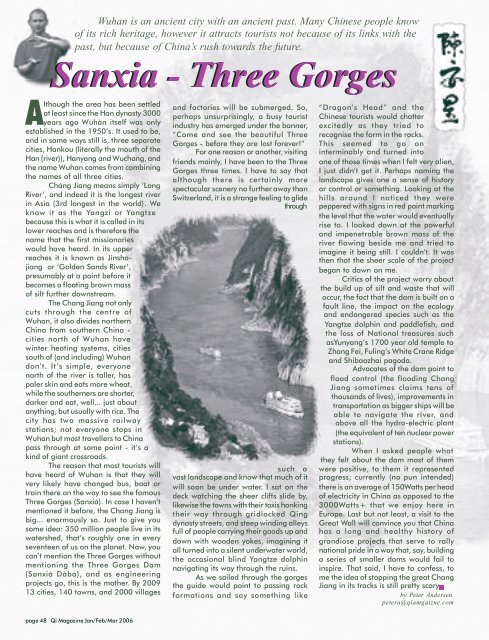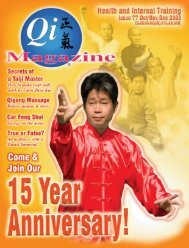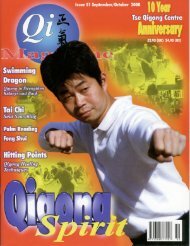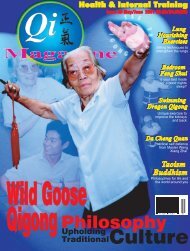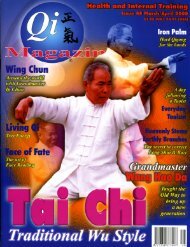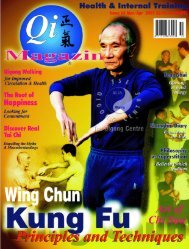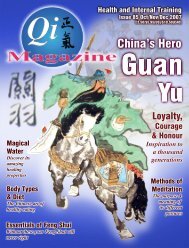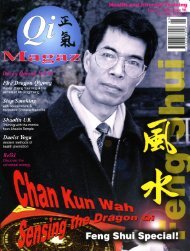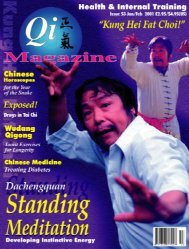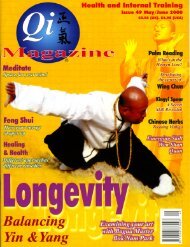Issue 78 - Tse Qigong Centre
Issue 78 - Tse Qigong Centre
Issue 78 - Tse Qigong Centre
- TAGS
- issue
- qigong
- qimagazine.com
You also want an ePaper? Increase the reach of your titles
YUMPU automatically turns print PDFs into web optimized ePapers that Google loves.
Wuhan is an ancient city with an ancient past. Many Chinese people know<br />
of its rich heritage, however it attracts tourists not because of its links with the<br />
past, but because of China’s rush towards the future.<br />
Sanxia - Three Gorges<br />
Although the area has been settled<br />
at least since the Han dynasty 3000<br />
years ago Wuhàn itself was only<br />
established in the 1950’s. It used to be,<br />
and in some ways still is, three separate<br />
cities, Hankou (literally the mouth of the<br />
Han (river)), Hanyang and Wuchang, and<br />
the name Wuhan comes from combining<br />
the names of all three cities.<br />
Cháng Jiang means simply ‘Long<br />
River’, and indeed it is the longest river<br />
in Asia (3rd longest in the world). We<br />
know it as the Yangzi or Yangtze<br />
because this is what it is called in its<br />
lower reaches and is therefore the<br />
name that the first missionaries<br />
would have heard. In its upper<br />
reaches it is known as Jinshajiang<br />
or ‘Golden Sands River’,<br />
presumably at a point before it<br />
becomes a floating brown mass<br />
of silt further downstream.<br />
The Chang Jiang not only<br />
cuts through the centre of<br />
Wuhan, it also divides northern<br />
China from southern China -<br />
cities north of Wuhan have<br />
winter heating systems, cities<br />
south of (and including) Wuhan<br />
don’t. It’s simple, everyone<br />
north of the river is taller, has<br />
paler skin and eats more wheat,<br />
while the southerners are shorter,<br />
darker and eat, well... just about<br />
anything, but usually with rice. The<br />
city has two massive railway<br />
stations; not everyone stops in<br />
Wuhan but most travellers to China<br />
pass through at some point - it’s a<br />
kind of giant crossroads.<br />
The reason that most tourists will<br />
have heard of Wuhan is that they will<br />
very likely have changed bus, boat or<br />
train there on the way to see the famous<br />
Three Gorges (Sanxiá). In case I haven’t<br />
mentioned it before, the Chang Jiang is<br />
big... enormously so. Just to give you<br />
some idea: 350 million people live in its<br />
watershed, that’s roughly one in every<br />
seventeen of us on the planet. Now, you<br />
can’t mention the Three Gorges without<br />
mentioning the Three Gorges Dam<br />
(Sanxiá Dàbà), and as engineering<br />
projects go, this is the mother. By 2009<br />
13 cities, 140 towns, and 2000 villages<br />
page 48 Qi Magazine Jan/Feb/Mar 2006<br />
and factories will be submerged. So,<br />
perhaps unsurprisingly, a busy tourist<br />
industry has emerged under the banner,<br />
“Come and see the beautiful Three<br />
Gorges - before they are lost forever!”<br />
For one reason or another, visiting<br />
friends mainly, I have been to the Three<br />
Gorges three times. I have to say that<br />
although there is certainly more<br />
spectacular scenery no further away than<br />
Switzerland, it is a strange feeling to glide<br />
through<br />
such a<br />
vast landscape and know that much of it<br />
will soon be under water. I sat on the<br />
deck watching the sheer cliffs slide by,<br />
likewise the towns with their taxis honking<br />
their way through gridlocked Qing<br />
dynasty streets, and steep winding alleys<br />
full of people carrying their goods up and<br />
down with wooden yokes, imagining it<br />
all turned into a silent underwater world,<br />
the occasional blind Yangtze dolphin<br />
navigating its way through the ruins.<br />
As we sailed through the gorges<br />
the guide would point to passing rock<br />
formations and say something like<br />
“Dragon’s Head” and the<br />
Chinese tourists would chatter<br />
excitedly as they tried to<br />
recognise the form in the rocks.<br />
This seemed to go on<br />
interminably and turned into<br />
one of those times when I felt very alien,<br />
I just didn’t get it. Perhaps naming the<br />
landscape gives one a sense of history<br />
or control or something. Looking at the<br />
hills around I noticed they were<br />
peppered with signs in red paint marking<br />
the level that the water would eventually<br />
rise to. I looked down at the powerful<br />
and impenetrable brown mass of the<br />
river flowing beside me and tried to<br />
imagine it being still. I couldn’t. It was<br />
then that the sheer scale of the project<br />
began to dawn on me.<br />
Critics of the project worry about<br />
the build up of silt and waste that will<br />
occur, the fact that the dam is built on a<br />
fault line, the impact on the ecology<br />
and endangered species such as the<br />
Yangtze dolphin and paddlefish, and<br />
the loss of National treasures such<br />
asYunyang’s 1700 year old temple to<br />
Zhang Fei, Fuling’s White Crane Ridge<br />
and Shibaozhai pagoda.<br />
Advocates of the dam point to<br />
flood control (the flooding Chang<br />
Jiang sometimes claims tens of<br />
thousands of lives), improvements in<br />
transportation as bigger ships will be<br />
able to navigate the river, and<br />
above all the hydro-electric plant<br />
(the equivalent of ten nuclear power<br />
stations).<br />
When I asked people what<br />
they felt about the dam most of them<br />
were positive, to them it represented<br />
progress; currently (no pun intended)<br />
there is an average of 150Watts per head<br />
of electricity in China as opposed to the<br />
3000Watts+ that we enjoy here in<br />
Europe. Last but not least, a visit to the<br />
Great Wall will convince you that China<br />
has a long and healthy history of<br />
grandiose projects that serve to rally<br />
national pride in a way that, say, building<br />
a series of smaller dams would fail to<br />
inspire. That said, I have to confess, to<br />
me the idea of stopping the great Chang<br />
Jiang in its tracks is still pretty scary<br />
by Peter Andersen.<br />
petera@qiamgaizne.com


